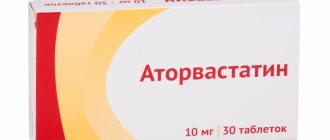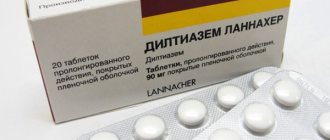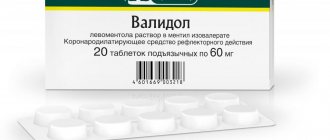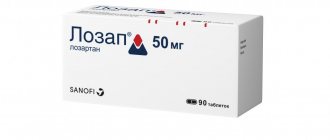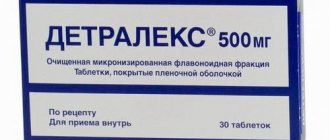"Veroshpiron" is a fast-acting diuretic that removes excess fluid from the body. This allows you to relieve swelling and normalize blood pressure. There are not many side effects and if the instructions are followed they are rare. The drug must be taken strictly according to the instructions, observing the daily and single dosage. Therapy lasts no more than 20 days in a row.
Description of the dosage form
Tablets are white or white with a creamy tint, round, flat-cylindrical, with a score on one side and a bevel, almost odorless or with a weak specific odor.
pharmachologic effect
Spironolactone is a potassium-sparing diuretic, a specific antagonist of aldosterone (mineralocorticosteroid hormone of the adrenal cortex) with prolonged action. In the distal parts of the nephron, spironolactone prevents the retention of sodium and water by aldosterone and suppresses the potassium-removing effect of aldosterone, reduces the synthesis of permeases in the aldosterone-dependent area of the collecting ducts and distal tubules. By binding to aldosterone receptors, it increases the excretion of sodium, chlorine and water ions in the urine, reduces the excretion of potassium and urea ions, and reduces the acidity of urine.
The maximum effect is observed 7 hours after oral administration and lasts for at least 24 hours. The hypotensive effect of the drug is due to the presence of a diuretic effect, which is not constant: the diuretic effect appears on days 2-5 of treatment.
Pharmacokinetics
Suction and distribution
When taken orally, it is quickly and completely absorbed from the gastrointestinal tract. The maximum concentration of Cmax canrenone in the blood plasma is achieved 2-4 hours after administration. Binds to plasma proteins by approximately 98% (canrenone - 90%). Volume of distribution (Vd) - 0.05 l/kg.
After daily administration of spironolactone at a dose of 100 mg for 15 days, Cmax is 80 ng/ml, the time to reach Cmax after the next morning dose is 2-6 hours.
Spironolactone penetrates poorly into organs and tissues, while itself and its metabolites penetrate the placental barrier, and canrenone passes into breast milk.
Metabolism
Spironolactone is converted into active metabolites: a metabolite containing sulfur (80%) and partly canrenone (20%).
Removal
Excreted by the kidneys: 50% - in the form of metabolites, 10% - unchanged and partially through the intestines. The half-life (T1/2) of spironolactone is 13-24 hours, of active metabolites - up to 15 hours. The elimination of canrenone (mainly by the kidneys) is two-phase, T1/2 in the first phase is 2-3 hours, in the second - 12-96 hours.
Pharmacokinetics in selected patient groups
In liver cirrhosis and heart failure, the duration of T1/2 increases without signs of cumulation, the likelihood of which is higher in chronic renal failure and hyperkalemia.
Veroshpiron tablets: main characteristics
"Veroshpiron" refers to diuretic drugs; its effects are an antagonist of the adrenal hormone aldosterone. Available in the form of capsules and tablets of identical composition.
The active ingredient is spironolactone. Each tablet contains 25 mg, and capsules contain dosages of 50 mg and 100 mg. Spironolactone stimulates water excretion, reduces potassium loss and the formation of permease enzymes. The most pronounced effect occurs 7 hours after taking the drug, it continues for 24 hours.
Due to regular exposure to spironolactone, a decrease in blood pressure is observed, which is associated with a diuretic effect. A decrease in blood pressure is observed 2-5 weeks after the start of therapy.
The medicine is sold in pharmacies only with a prescription. It is necessary to agree with the doctor, who determines the duration of the course and dosage. The drug is stored at room temperature (maximum 30 degrees).
Indications for use of Veroshpiron
- Essential hypertension (as part of combination therapy);
- edema syndrome in chronic heart failure (can be used in monotherapy and in combination with standard therapy);
- conditions in which secondary hyperaldosteronism may be detected, including cirrhosis of the liver accompanied by ascites and/or edema, nephrotic syndrome, as well as other conditions accompanied by edema;
- hypokalemia/hypomagnesemia (as an adjuvant for its prevention during treatment with diuretics and when it is impossible to use other methods of correcting potassium levels);
- primary hyperaldosteronism (Conn's syndrome) - for a short preoperative course of treatment;
- to establish the diagnosis of primary hyperaldosteronism.
Contraindications to the use of Veroshpiron
- Hypersensitivity to any of the components of the drug;
- Addison's disease;
- hyperkalemia;
- hyponatremia;
- severe renal failure (creatinine clearance less than 10 ml/min);
- anuria;
- pregnancy;
- lactation period (breastfeeding);
- children under 3 years of age (for solid dosage form);
- lactase deficiency, lactose intolerance, glucose-galactose malabsorption syndrome (since the drug contains lactose monohydrate).
With caution: hypercalcemia, metabolic acidosis, AV block (hyperkalemia enhances it); diabetes mellitus (with confirmed or suspected chronic renal failure); diabetic nephropathy; surgical interventions during anesthesia; taking medications that cause gynecomastia; local and general anesthesia; elderly age; menstrual irregularities, enlarged mammary glands; liver failure, liver cirrhosis.
Special instructions for the use of the drug Veroshpiron
During treatment with Veroshpiron, a transient increase in urea nitrogen in the blood is possible, especially if the drug is used with reduced renal function and hyperkalemia, as well as the development of moderate reversible hyperchloremic metabolic acidosis. In this regard, in patients with kidney and liver diseases and in the elderly, it is necessary to systematically monitor serum electrolytes and indicators of renal function. The use of Veroshpiron makes it difficult to determine the content of digoxin in the blood serum, cortisol and adrenaline in the blood plasma. Although the drug does not have a direct effect on carbohydrate metabolism, when used in patients with diabetes mellitus, especially with diabetic nephropathy, special care must be taken due to the risk of hyperkalemia. Patients receiving Veroshpiron should not be additionally prescribed potassium supplements or a diet high in potassium, as this may cause hyperkalemia. Also, Veroshpiron should not be prescribed in combination with other drugs that cause potassium retention. The risk of developing hyperkalemia is increased in patients with insufficient renal function. During the initial period of use of the drug, the duration of which is determined individually, it is prohibited to drive vehicles and perform other work that requires speed of physical and mental reactions. In the future, the possibility of their implementation is determined individually. It is prohibited to drink alcohol while taking Veroshpiron. It is advisable to use Veroshpiron in combination with other diuretics, limiting the use of table salt and liquid; if necessary, maintain bed rest. For children under 6 years of age, the drug is prescribed in tablet form.
Side effects
From the gastrointestinal tract: nausea, vomiting, diarrhea, ulceration and bleeding from the gastrointestinal tract, gastritis, intestinal colic, abdominal pain, constipation.
From the liver: impaired liver function.
From the nervous system: ataxia, lethargy, dizziness, headache, drowsiness, lethargy, confusion, muscle spasm.
From the blood and lymphatic system: agranulocytosis, thrombocytopenia, megaloblastosis.
From laboratory parameters: hyperuricemia, hypercreatininemia, increased urea concentration, disturbance of water and electrolyte balance (hyperkalemia, hyponatremia) and acid-base status (metabolic hyperchloremic acidosis or alkalosis).
From the endocrine system: deepening of the voice, in men - gynecomastia (the likelihood of development depends on the dose, duration of treatment and is usually reversible, and disappears after discontinuation of the drug, and only in rare cases the mammary gland remains slightly enlarged), decreased potency and erection; in women - menstrual irregularities, dysmenorrhea, amenorrhea, metrorrhagia during menopause, hirsutism, pain in the mammary glands, breast carcinoma (no connection with the drug has been established).
Allergic reactions: urticaria, maculopapular and erythematous rash, drug fever, pruritus, eosinophilia, Stevens-Johnson syndrome, toxic epidermal necrolysis.
From the skin and subcutaneous tissues: alopecia, hypertrichosis.
From the kidneys and urinary tract: acute renal failure.
Musculoskeletal and connective tissue disorders: calf muscle cramps.
From the respiratory system: shortness of breath.
If any of the above adverse reactions worsen or other adverse events not listed in the instructions occur, the patient should inform the doctor.
Side effects of the drug Veroshpiron
Hyperkalemia and hyponatremia; with long-term use of Veroshpiron, gynecomastia and erectile dysfunction in men, menstrual irregularities and enlarged mammary glands in women are possible; It is possible to change the timbre of the voice in both men and women. Dysfunction of the digestive system may also occur (vomiting, diarrhea, gastrointestinal bleeding, gastric and duodenal ulcers, gastritis); disorders of the central nervous system (lethargy, ataxia, headache), skin reactions (maculopapular or erythematous skin rash), agranulocytosis. Side effects are usually reversible and disappear after discontinuation of Veroshpiron.
Drug interactions
Reduces the effect of anticoagulants, indirect anticoagulants (heparin, coumarin derivatives, indanedione) and the toxicity of cardiac glycosides (since normalization of potassium content in the blood prevents the development of toxicity).
Enhances the metabolism of phenazone (antipyrine).
Reduces the sensitivity of blood vessels to norepinephrine (care is required when performing anesthesia), increases T1/2 of digoxin - digoxin intoxication is possible.
Increases the toxic effect of lithium due to decreased clearance.
Possibly enhances the effect of non-depolarizing muscle relaxants (for example, tubocurarine).
Accelerates the metabolism and excretion of carbenoxolone.
Carbenoxolone promotes sodium retention by spironolactone.
GCS and diuretics (thiazides and thiazide-like, furosemide, ethacrynic acid) enhance and accelerate the diuretic and natriuretic effects.
Enhances the effect of diuretic and antihypertensive drugs.
NSAIDs reduce the diuretic and natriuretic effects, increasing the risk of hyperkalemia.
Alcohol (ethanol), barbiturates, and narcotic substances increase orthostatic hypotension.
GCS enhance the diuretic and natriuretic effect in hypoalbuminemia and/or hyponatremia.
The risk of developing hyperkalemia increases when taken with potassium preparations, potassium supplements and potassium-sparing diuretics, ACE inhibitors (acidosis), angiotensin II receptor antagonists, aldosterone blockers, indomethacin, cyclosporine.
Salicylates and indomethacin reduce the diuretic effect of spironolactone.
Ammonium chloride and cholestyramine contribute to the development of hyperkalemic metabolic acidosis.
Fludrocortisone causes a paradoxical increase in tubular secretion of potassium.
Spironolactone reduces the effect of mitotane.
Enhances the effects of triptorelin, buserelin, gonadorelin.
Veroshpiron 25 mg No. 20 tablet.
Before using the drug, you should definitely consult your doctor and read the instructions carefully.
Tradename
Verospiron Verospiron
Compound
Tablets 1 tab. spironolactone 25 mg Excipients: lactose. 20 pcs. — cellular contour packages (1) — cardboard packs.
Pharmacokinetics
Suction
When taken orally, it is absorbed from the gastrointestinal tract. Bioavailability is 90%. Eating increases the absorption and bioavailability of spironolactone.
Distribution
Plasma protein binding - 90%. Spironolactone and its metabolites cross the placenta and are excreted in breast milk.
Metabolism
Rapidly metabolized in the liver. The main metabolites of spironolactone are canrenone and 7-alpha-(thiomethyl)-spironolactone.
Removal
Spironolactone and its metabolites are excreted mainly in the urine and, to a lesser extent, in the feces.
pharmachologic effect
A potassium-sparing diuretic, it is a competitive aldosterone antagonist. In the distal parts of the renal tubules, the drug inhibits the action of aldosterone, aimed at retaining sodium and water in the body, as well as increasing potassium secretion. Due to the blockade of aldosterone receptors, the urinary excretion of sodium and chlorine ions increases, and the excretion of potassium and hydrogen ions decreases.
The hypotensive effect of the drug is due to the presence of a diuretic effect.
The diuretic effect develops on days 2-5 of treatment and persists for 2-3 days after discontinuation of the drug.
Indications for use
- primary hyperaldosteronism (to clarify the diagnosis and short-term preoperative treatment, as well as for long-term treatment if surgery is not possible);
- edema syndrome (combined use with other diuretics is advisable) in chronic heart failure (in the absence of effect or intolerance to other types of treatment, as well as if it is necessary to increase the effects of other diuretics), liver cirrhosis (accompanied by edema and/or ascites), nephrotic syndrome ( if treatment of the underlying disease is ineffective, limiting the consumption of table salt and liquid, as well as when using other diuretics);
- essential arterial hypertension (in combination with other antihypertensive drugs; the use of the drug is preferable for hypokalemia);
- hypokalemia (if it is impossible to use other methods of correcting potassium levels, including to prevent hypokalemia during treatment with digitalis preparations).
Dosage regimen
In case of primary hyperaldosteronism during preparation for surgery, Veroshpiron is prescribed in a daily dose of 100-400 mg. If for some reason surgical treatment is not carried out, long-term use of Veroshpiron at the minimum effective dose is possible (the initial dose of the drug is reduced every 14 days to the lowest dose that has an effect). With long-term use, to reduce the risk of side effects, it is advisable to prescribe Veroshpiron in combination with other diuretics.
For edema syndrome in chronic heart failure, liver cirrhosis, nephrotic syndrome, the drug is prescribed to adults in an initial daily dose of 100 mg, divided into 2 doses. In the future, depending on clinical effectiveness, the daily dose can be reduced to 25 mg or increased to 200 mg.
If the expected diuretic effect is not observed, it is advisable to prescribe a diuretic acting on the proximal renal tubules. In this case, it is recommended not to change the dose of Veroshpiron.
For children, the daily dose of the drug is 3 mg/kg body weight (in 1 or 2 doses).
For essential arterial hypertension, the initial daily dose is 50-100 mg (divided into 2 doses). The duration of treatment is at least 2 weeks (since during this time the maximum hypotensive effect develops). Then an individual dose adjustment of the drug is carried out. It is recommended to use Veroshpiron in combination with other antihypertensive drugs.
For hypokalemia, Veroshpiron is used in a daily dose of 25-100 mg, if oral administration of potassium supplements and other methods of replenishing its deficiency are ineffective.
Side effects
From the side of water and electrolyte balance: hyperkalemia, hyponatremia, electrolyte imbalance.
From the endocrine system: with long-term treatment in men - gynecomastia and decreased erection, in women - engorgement of the mammary glands, menstrual irregularities; It is possible to change the timbre of the voice in both men and women.
From the digestive system: rarely - nausea, vomiting, diarrhea, gastritis, stomach and duodenal ulcers, gastritis, gastric bleeding.
From the side of the central nervous system: rarely - ataxia, lethargy, headache.
Dermatological reactions: rarely - maculopapular rash, erythema.
Side effects usually regress after discontinuation of the drug.
Contraindications
- anuria;
- acute renal failure;
- severe renal dysfunction (creatinine clearance<10 ml/min);
- hyperkalemia;
- hyponatremia;
- pregnancy;
- lactation (breastfeeding);
- hypersensitivity to spironolactone and other components of the drug.
Drug interactions
With simultaneous use of Veroshpiron with salicylates, a decrease in the diuretic effect is observed.
With the simultaneous use of Veroshpiron with other diuretics, an increase in diuresis is observed.
With simultaneous use of Veroshpiron with antihypertensive drugs, the hypotensive effect may be enhanced.
When Veroshpiron is used simultaneously with potassium supplements or potassium-sparing diuretics, the risk of developing hyperkalemia increases.
With simultaneous use of Veroshpiron with NSAIDs, the risk of developing hyperkalemia increases.
With simultaneous use of Veroshpiron with ACE inhibitors and ammonium chloride, the risk of developing acidosis increases.
With the simultaneous use of Veroshpiron with fludrocortisone, a paradoxical increase in tubular secretion of potassium is observed.
When Veroshpiron is used simultaneously with mitotane, the effect of the latter decreases.
With simultaneous use, Veroshpiron reduces the effect of indirect anticoagulants (coumarin derivatives).
With the simultaneous use of Veroshpiron with triptorelin, buserelin, gonadorelin, the effect of the latter is enhanced.
Pharmacokinetic interaction
When used simultaneously with Veroshpiron, the half-life of digoxin increases. This can lead to an increase in the concentration of digoxin in the blood, up to toxic levels (if it is necessary to use them together, the dose should be reduced or the interval between doses of digoxin should be increased).
special instructions
Although the drug does not have a direct effect on carbohydrate metabolism, special caution is required when prescribing Veroshpiron for diabetes mellitus (especially complicated by diabetic nephropathy) due to the risk of developing hyperkalemia.
When using Veroshpiron for edematous syndrome, it is recommended that the simultaneous use of other diuretics, limiting the intake of table salt and liquid, and, if necessary, bed rest.
Due to the possibility of developing hyperkalemia, hyponatremia, hyperchloremic metabolic acidosis and a transient increase in blood urea nitrogen during the use of the drug, systematic monitoring of serum electrolytes and indicators of renal function is required.
It should be taken into account that during the use of Veroshpiron, the determination of digoxin, cortisol and adrenaline in plasma and serum is difficult.
During treatment with Veroshpiron, alcohol consumption is prohibited.
According to some literature data, in experimental studies on animals that were administered doses of Veroshpiron for a long time, many times exceeding the maximum permissible dose for humans, the occurrence of cancer and myeloid leukemia was noted. Taking into account these data, it is recommended to avoid excessively prolonged use of the drug.
Impact on the ability to drive vehicles and operate machinery
During the initial period of using the drug Veroshpiron, driving a car and other activities that require rapid psychomotor reactions are prohibited. In the future, the possibility of engaging in these types of activities is determined individually.
Overdose
Symptoms: nausea, vomiting, drowsiness, confusion, skin rash, diarrhea. Possible disturbance of water-electrolyte balance and dehydration of the body.
Treatment: there is no specific antidote. Symptomatic treatment of dehydration and water-electrolyte imbalance should be carried out by prescribing diuretics that increase potassium excretion, parenteral administration of a glucose solution (dextrose) with insulin. In severe cases, hemodialysis should be performed.
Pregnancy and lactation
Veroshpiron is contraindicated for use during pregnancy and breastfeeding.
Storage conditions and periods
The drug should be stored at a temperature of 15° to 30°C. Shelf life: 5 years.
Conditions for dispensing from pharmacies
The drug is available with a prescription.
Dosage of Veroshpiron
Inside.
Essential hypertension
The daily dose for adults is usually 50-100 mg once and can be increased to 200 mg, and the dose should be increased gradually, once every 2 weeks. To achieve an adequate response to therapy, the drug must be taken for at least 2 weeks. If necessary, adjust the dose.
Idiopathic hyperaldosteronism
Prescribed at a dose of 100-400 mg/day.
Severe hyperaldosteronism and hypokalemia
Prescribe 300 mg/day (maximum 400 mg/day) in 2-3 doses; as the condition improves, the dose is gradually reduced to 25 mg/day.
Hypokalemia and/or hypomagnesemia
For hypokalemia and/or hypomagnesemia caused by diuretic therapy, the drug is prescribed at a dose of 25-100 mg/day, once or in several doses. The maximum daily dose is 400 mg if oral potassium supplements or other methods of replenishing the deficiency are ineffective.
Diagnosis and treatment of primary hyperaldosteronism
As a diagnostic agent for a short diagnostic test: for 4 days, 400 mg/day, divided into several doses per day. If the concentration of potassium in the blood increases while taking the drug and decreases after its discontinuation, the presence of primary hyperaldosteronism can be assumed.
For a long-term diagnostic test: at the same dose for 3-4 weeks. When correction of hypokalemia and arterial hypertension is achieved, the presence of primary hyperaldosteronism can be assumed.
Short course of preoperative therapy for primary hyperaldosteronism
After the diagnosis of hyperaldosteronism has been established using more accurate diagnostic methods, Verospilactone should be taken at a dose of 100-400 mg/day, divided into 1-4 doses during the entire period of preparation for surgery. If surgery is not indicated, then the drug Verospilactone is used for long-term maintenance therapy, using the lowest effective dose, which is selected individually for each patient.
Edema due to nephrotic syndrome
The daily dose for adults is usually 100-200 mg/day. No effect of spironolactone on the underlying pathological process has been identified, and therefore the use of this drug is recommended only in cases where other types of therapy are ineffective.
Edema syndrome due to chronic heart failure
Daily, for 5 days, 100-200 mg/day in 2-3 divided doses, in combination with a loop or thiazide diuretic. Depending on the effect, the daily dose is reduced to 25 mg. The maintenance dose is selected individually. Maximum dose 200 mg/day.
Edema due to liver cirrhosis
If the ratio of sodium and potassium ions (Na+/K+) in the urine exceeds 1.0, then the daily dose for adults is usually 100 mg. If the ratio is less than 1.0, then the daily dose for adults is usually 200-400 mg. The maintenance dose is selected individually.
Edema in children
The initial dose in children over 3 years of age is 1-3.3 mg/kg body weight or 30-90 mg/m2/day in 1-4 doses. After 5 days, the dose is adjusted and, if necessary, increased by 3 times compared to the original.
Pharmacological properties of the drug Veroshpiron
Spironolactone (γ-lactone-3-(3-oxo-7α-thioacetyl-17β-hydroxy-4-androsten-17-α-yl)propionic acid) is a potassium-sparing diuretic, a competitive aldosterone antagonist. Affects the distal convoluted renal tubules. Due to the blockade of aldosterone receptors, the urinary excretion of sodium, chlorine and water ions increases, and the excretion of potassium and hydrogen ions decreases. As an aldosterone antagonist, spironolactone prevents the replacement of sodium with potassium in the distal renal tubules and reduces potassium excretion. The drug can be used as monotherapy or in combination with other diuretics acting on the proximal renal tubules. The hypotensive effect of Veroshpiron is due to its diuretic effect. It is well absorbed in the digestive tract, characterized by high bioavailability, about 90% of the drug binds to blood plasma proteins. During the biotransformation of spironolactone, active metabolites are formed (7-α-thiomethylspironolactone and caprenon), which are excreted mainly in the urine, and in small quantities in feces. The half-life averages 12.5 hours. It penetrates the placenta and is also excreted in breast milk.
Overdose
Symptoms: nausea, vomiting, dizziness, diarrhea, skin rash, hyperkalemia (paresthesia, muscle weakness, arrhythmias), hyponatremia (dry mouth, thirst, drowsiness), hypercalcemia, dehydration, increased urea concentration.
Treatment: gastric lavage, symptomatic treatment of dehydration and arterial hypotension. In case of hyperkalemia, it is necessary to normalize the water-electrolyte balance with the help of potassium-removing diuretics, rapid parenteral administration of a 5-20% dextrose (glucose) solution with insulin at the rate of 0.25-0.5 units per 1 g of dextrose (glucose); can be re-entered if necessary. In severe cases, hemodialysis is performed.


